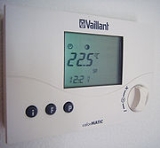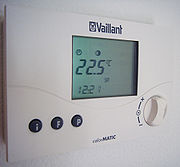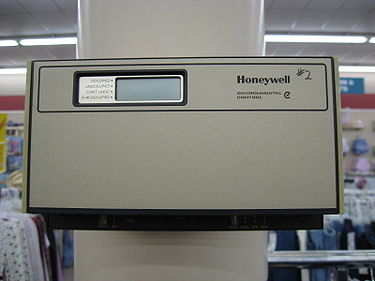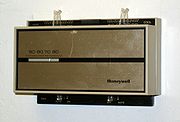
Programmable thermostat
Encyclopedia

Thermostat
A thermostat is the component of a control system which regulates the temperature of a system so that the system's temperature is maintained near a desired setpoint temperature. The thermostat does this by switching heating or cooling devices on or off, or regulating the flow of a heat transfer...
which is designed to adjust the temperature according to a series of programmed settings that take effect at different times of the day. Programmable thermostats may also be called setback thermostats or clock thermostats.
Benefits

For example, during cooling season, a programmable thermostat used in a home may be set to allow the temperature in the house to rise during the workday when no one will be at home. It may then be set to turn on the air conditioning before the arrival of occupants, allowing the house to be cool upon the arrival of the occupants while still having saved air conditioning energy during the peak outdoor temperatures. The reduced cooling required during the day also decreases the demands placed upon the electrical supply grid.
Conversely, during the heating season, the programmable thermostat may be set to allow the temperature in the house to drop when the house is unoccupied during the day and also at night after all occupants have gone to bed, re-heating the house prior to the occupants arriving home in the evening or waking up in the morning. Since most people sleep better when a room is cooler and the temperature differential between the interior and exterior of a building will be greatest on a cold winter night, this reduces energy losses.
Similar scenarios are available in commercial buildings, with due consideration of the building's occupancy patterns.
Controversy
While programmable thermostats may be able to save energy when used correctly, little or no average energy savings has been demonstrated in residential field studies. Difficulty with usability in residential environments appears to lead to lack of persistence of energy savings in homes. According to the US EPA regarding residential programmable thermostat, "Available studies indicate no savings from programmable thermostat (PT) installation. Some studies indicate slight increased consumption." This is supported with studies by Nevius and Pigg , Cross and Judd and others and Peffer et al has a recent review of the topic.Clock thermostats

This design, while simple to manufacture and relatively easy to program, sacrifices comfort on weekends since the program is repeated each of the seven days of the week with no variation. To overcome this deficit, a push-button is sometimes provided to allow the user to explicitly switch (once) the current period from hot period to a cold period or vice-versa; the usual use of this button is to over-ride a "set back" that takes place during the workday when the home is normally unoccupied.
The clock mechanism is electrical, and two methods have commonly been used to drive it:
- A separate, continuous source of 24 voltVoltThe volt is the SI derived unit for electric potential, electric potential difference, and electromotive force. The volt is named in honor of the Italian physicist Alessandro Volta , who invented the voltaic pile, possibly the first chemical battery.- Definition :A single volt is defined as the...
s ACAlternating currentIn alternating current the movement of electric charge periodically reverses direction. In direct current , the flow of electric charge is only in one direction....
is provided to the thermostat, or - A rechargeable batteryNickel-cadmium batteryThe nickel–cadmium battery ' is a type of rechargeable battery using nickel oxide hydroxide and metallic cadmium as electrodes....
in the thermostat operates the clock. The battery charges when the thermostat is not calling for heat and 24 VAC is available across the thermostat's terminals, and discharges to operate the clock when the thermostat is commanding heating or cooling.
Digital thermostats

As with clock thermostats, basic digital thermostats may have just one cycle that is run every day of the week. More-sophisticated thermostats may have a weekday schedule and a separate weekend schedule (so-called "5-2" setting) or separate Saturday and Sunday schedules (so-called "5-1-1" settings), while other thermostats will offer a separate schedule for each day of the week ("7 day" settings). The selection of which days are defined as the "weekend" is arbitrary, depending on the user's heating and cooling schedule requirements. Often, a manufacturer will sell three similar thermostats offering each of those levels of functionality, and there is no obvious difference in the thermostats other than the factory programming and the price.
Most digital thermostats have separate programs for heating and cooling, and may feature a digital or manual switch to turn on the furnace blower for air circulation, even when the system isn't heating or cooling. More-sophisticated models may be programmed to run the circulating fan for a brief 5-10 minute period in the event a heating or cooling cycle has not taken place during the previous hour. This is particularly useful in buildings subject to stratification where without frequent air circulation, hot air rises and separates from the cooler air that falls.
Digital thermostats may also have a user-programmable air filter change reminder; this counts the accumulated run-time of the heating/cooling system and reminds the user when it is time to change the filter. The feature often displays the accumulated run-time either as an aggregate of both heating and cooling or displaying each time separately.
Some digital thermostats have the capability of being programmed using a touch-tone telephone or over the Internet.
Digital thermostats are usually powered one of three ways:
- A sophisticated power circuit operates from the 24 VAC supply when the thermostat is not calling, and operates from the current flowing in the thermostat circuit when the thermostat is calling. A battery is used to provide back-up during power failures.
- A rechargeable battery operates the thermostat just as in the clock thermostat, charging when the thermostat is not calling and discharging while the thermostat is calling.
- A non-rechargeable battery always powers the thermostat. To limit the amount of power drawn from the battery, such thermostats use an impulse relayRelayA relay is an electrically operated switch. Many relays use an electromagnet to operate a switching mechanism mechanically, but other operating principles are also used. Relays are used where it is necessary to control a circuit by a low-power signal , or where several circuits must be controlled...
that does not require the continuous application of power to the relay's coil. These thermostats can be used on millivolt circuits, as well as conventional 24 VAC circuits. Battery life is typically one to two years.
Digital thermostats with PID controller
More expensive models have a built-in PID controllerPID controller
A proportional–integral–derivative controller is a generic control loop feedback mechanism widely used in industrial control systems – a PID is the most commonly used feedback controller. A PID controller calculates an "error" value as the difference between a measured process variable and a...
, so that the thermostat learns how the system will react to its commands. Programming the morning temperature to be 21° C
Celsius
Celsius is a scale and unit of measurement for temperature. It is named after the Swedish astronomer Anders Celsius , who developed a similar temperature scale two years before his death...
at 7:00 AM, for instance, makes sure that at that time the temperature will be 21° C. A standard programmable thermostat would simply start working toward 21° at 7:00 AM. The PID controller decides at what time the system should be activated in order to reach the desired temperature at the desired time. It knows this by remembering the past behavior of the room, and the current temperature of the room. This is called optimal start.
It also makes sure that the temperature is very stable (for instance, by reducing overshoots at the end of the heating cycle) so that the comfort level is increased.
Commercial thermostats
In commercial applications, the thermostat may not contain any clock mechanism. Instead, another means may be used to select between the "hotter" and "colder" settings. For example, if the thermostat uses pneumatic controlsPneumatics
Pneumatics is a branch of technology, which deals with the study and application of use of pressurized gas to effect mechanical motion.Pneumatic systems are extensively used in industry, where factories are commonly plumbed with compressed air or compressed inert gases...
, a change in the air pressure supplied to the thermostat may select between the "hotter" and "colder" settings, and this air pressure is determined by a central regulator. With electronic controls, a specific signal may indicate whether to operate at the "hotter" or "colder" setting.
Terminal types
| Terminal Code | Color | Description |
|---|---|---|
| R | Red | 24 volt |
| RH / RC | Red | 24 volt HEAT / COOL load |
| C / X | 24 volt Common | |
| W / W1 | White | Heat |
| W2 | White | Backup Heat |
| Y / Y1 | Yellow | Cool |
| G | Green | Fan Fan (mechanical) A mechanical fan is a machine used to create flow within a fluid, typically a gas such as air.A fan consists of a rotating arrangement of vanes or blades which act on the air. Usually, it is contained within some form of housing or case. This may direct the airflow or increase safety by preventing... |
| O / OB | Orange | Reversing valve Reversing valve thumb|right|293px|border|A reversing valve removed from an HVAC heat pump for replacement.A reversing valve a type of valve and is a component in a heat pump, that changes the direction of refrigerant flow. By reversing the flow of refrigerant, the heat pump refrigeration cycle is changed from... (Heat Pump) |
| E | Emergency Heat (Heat Pump) |
External links
- Energy Savers, Programmable thermostat (EERE).
- Honeywell RTH7600D Programmable Thermostat
- Honeywell chronotherm III
- "How A Thermostat Tends Your Furnance" 1951 article on the basics of the automatic furnace thermostats -- ie good drawings and illustrations with page 149 showing the first clock thermostats

